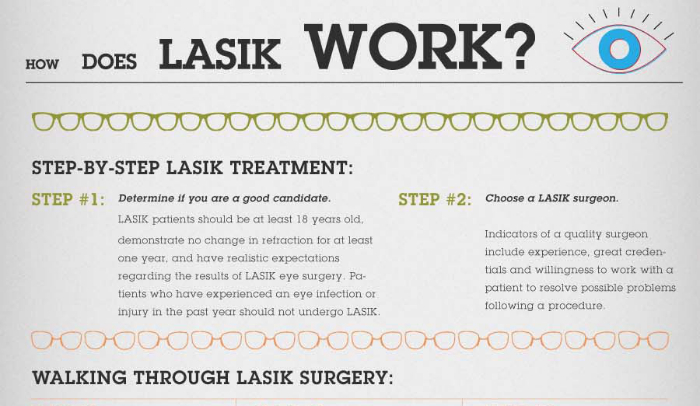Interested In Learning About The Distinctions Amongst SMILE, LASIK, And PRK Procedures For The Eyes?
Interested In Learning About The Distinctions Amongst SMILE, LASIK, And PRK Procedures For The Eyes?
Blog Article
Created By-Munksgaard Tang
If you've been taking into consideration SMILE eye surgery, you may wonder exactly how it compares to LASIK and PRK. Each treatment has its very own collection of benefits and factors to consider. From quicker recovery times to potential risks, there are key distinctions you need to be aware of before deciding. Understanding these distinctions will certainly assist you make an educated selection that lines up with your details needs and expectations. Curious to recognize even more concerning how these treatments contrast in detail? Keep exploring to gain a thorough understanding of SMILE, LASIK, and PRK.
SMILE Eye Surgical Procedure Summary
If you're considering SMILE eye surgical treatment, you'll discover it to be a minimally intrusive procedure with a quick recovery time. During SMILE (Tiny Incision Lenticule Removal), a laser is made use of to produce a small, exact laceration in the cornea to get rid of a small piece of cells, improving it to fix your vision. This differs from LASIK, where a flap is created, and PRK, where the outer layer of the cornea is completely eliminated.
One of the crucial advantages of SMILE is its minimally invasive nature, bring about a faster healing process and much less pain post-surgery. The recovery time for SMILE is relatively fast, with several patients experiencing boosted vision within a day or more. This makes it a popular choice for those looking for a hassle-free and efficient vision correction procedure. In 7 days after cataract surgery , SMILE has been revealed to have a lower threat of completely dry eye syndrome compared to LASIK, making it a positive alternative for people worried concerning this possible side effect.
Differences In Between SMILE, LASIK, and PRK
When comparing SMILE, LASIK, and PRK eye surgeries, it is very important to recognize the unique strategies utilized in each procedure for vision adjustment.
SMILE (Tiny Cut Lenticule Removal) is a minimally invasive treatment that includes developing a small cut to draw out a lenticule from the cornea, improving it to correct vision.
LASIK (Laser-Assisted In Situ Keratomileusis) entails producing a slim flap on the cornea, making use of a laser to reshape the underlying cells, and after that rearranging the flap.
https://see-lasik19763.ttblogs.com/14823402/choosing-the-right-intraocular-lens-for-cataract-surgical-procedure (Photorefractive Keratectomy) removes the outer layer of the cornea prior to reshaping the cells with a laser.
The main distinction depends on the means the cornea is accessed and dealt with. LASIK Dry Eyes How Long is flapless, making it a great alternative for people with thin corneas or those associated with get in touch with sporting activities. LASIK provides fast visual recuperation due to the flap creation, however it may present a higher risk of flap-related problems. PRK, although having a much longer healing period, stays clear of flap-related issues altogether.
Understanding these variances is critical in picking the most ideal treatment for your vision adjustment requirements.
Advantages And Disadvantages Comparison
To assess the advantages and disadvantages of SMILE, LASIK, and PRK eye surgical procedures, it's necessary to consider the particular advantages and possible limitations of each procedure. SMILE surgical treatment uses the advantage of a minimally intrusive procedure, with a smaller sized cut and potentially quicker healing time compared to LASIK and PRK. It likewise decreases the danger of completely dry eye post-surgery, a common side effect of LASIK. However, SMILE may have restrictions in treating higher degrees of nearsightedness or astigmatism compared to LASIK.
LASIK surgery offers fast visual healing and marginal discomfort throughout the treatment. It's extremely reliable in treating a vast array of refractive errors, consisting of myopia, hyperopia, and astigmatism. Yet, LASIK brings a threat of flap difficulties, which can impact the corneal structure.
PRK eye surgery, while not as popular as LASIK, prevents creating a corneal flap, reducing the risk of flap-related issues. It's suitable for individuals with thin corneas or uneven corneal surface areas. Nevertheless, PRK has a longer recuperation time and might involve extra discomfort during the healing procedure.
Conclusion
So, when it pertains to picking in between SMILE, LASIK, and PRK, consider it like choosing the excellent pair of shoes. SMILE resembles a sleek, comfortable pair of sneakers - quick and simple.
LASIK is a lot more like stylish high heels - showy and quickly, but with some possible threats.
PRK resembles tough treking boots - trusted and sturdy, yet calling for a bit even more time and effort.
Eventually, the best option depends upon your private demands and choices.
